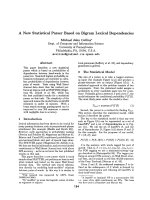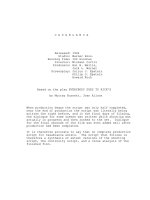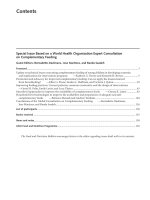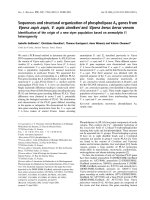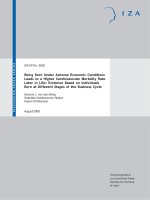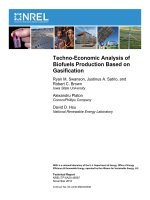- Trang chủ >>
- Sư phạm >>
- Sư phạm hóa
New bioactive biomaterials based on quaternized chitosan
Bạn đang xem bản rút gọn của tài liệu. Xem và tải ngay bản đầy đủ của tài liệu tại đây (371.77 KB, 7 trang )
1582
J. Agric. Food Chem. 2008, 56, 1582–1588
New Bioactive Biomaterials Based on Quaternized
Chitosan
RACHID BELALIA,†,§ STÉPHANE GRELIER,† MOHAMMED BENAISSA,§
VÉRONIQUE COMA*,†
AND
Université Bordeaux 1, INRA, CNRS, UMR 5103 US2B, 351 cours de la liberation,
33405 Talence, France, and Laboratoire de Physico-Chimie et Génie Agroalimentaires, Faculté des
Sciences, Université Hassan II - Aîn Chock, B.P. 5366, Maarif 20100, Casablanca, Morocco
Chitosan was chemically modified to produce quaternary ammonium salts in order to improve its
antimicrobial activity and physicochemical properties. Quaternization of N-alkyl chitosan derivatives
was carried out using alkyl iodide to elaborate water-soluble cationic polyelectrolytes (N,N,Ntrimethylchitosan, TMC). TMC was characterized by 1H NMR spectroscopy; the quaternization degree
was determined from 1H NMR spectra and by titration of iodide ion. The antibacterial activity of
hydroxypropylcellulose (HPC) films or coatings associated with chitosan or TMC as biocide was
evaluated against the growth of Listeria monocytogenes and Salmonella typhimurium. The
HPC-chitosan and HPC-TMC coatings exhibited a total inhibition on solid medium of both bacterial
strains. Experiments conducted in liquid medium showed that the inhibitory activity against the growth
of Listeria innocua was improved after chemical modification. Moreover, physicochemical properties
of films were evaluated to determine their potential for food applications. The addition of the
antibacterial agents showed a significant impact on the moisture barrier and mechanical properties
of HPC films.
KEYWORDS: Active packaging; chitosan; N,N,N-trimethylchitosan; antibacterial activity; chemical modification
INTRODUCTION
Due to recent outbreaks of contaminations associated with
food products, as well as growing concerns regarding the safety
of intermediate-moisture foods, active packaging has been
greatly developed in recent years. Principal active-packaging
systems involve oxygen scavenging, moisture absorption, carbon
dioxide or ethanol generation, and finally antimicrobial systems.
In addition, due to environmental considerations, the elaboration of biopackagings from renewable resources constitutes a
very interesting option complementary to recycling. Throughout
the past decade, bioactive chitosan matrices have been an
interesting research topic for applications in food preservation.
This copolymer including both -1,4-anhydroglucosamine and
N-acetyl- -1,4-anhydroglucosamine units is a biodegradable
polysaccharide exhibiting bioactive amino groups (Figure 1).
Many papers have been published on the utilization of
chitosan as a bioactive matrix (1–4). The chitosan acts on both
Gram-positive and Gram-negative bacteria, but its action seems
to be less significant against Gram-negative strains (5, 6).
* Author to whom correspondence should be addressed [telephone
(33) 5 40 00 29 13; fax (33) 5 40 00 64 39; e-mail ].
†
Université Bordeaux 1.
§
Université Hassan II - Aîn Chock.
Helander et al. (7) showed that highly concentrated chitosan
has a bactericidal effect against Gram-negative bacteria such
as Salmonella typhimurium (20000 ppm). Ouattara et al. (8)
reported that chitosan films exhibited inhibitory effect against
Serratia liquefaciens. According to Moller et al. (9), composite
films obtained by the combination in the same proportions of
chitosan and hydroxypropylmethyl cellulose inhibited completely the growth of Listeria monocytogenes.
However, the nonsolubility of chitosan in neutral and alkaline
aqueous solutions limits its applications as a food preservative
or as bioactive matrices. The biopolymer is soluble only in weak
acid solutions. Moreover, the bioactivity is due to the cationic
charges on the macromolecular chain, controlled by the solvent
pH. In acid solutions, at a pH of <6.2, amino groups are mainly
protonated and the soluble polysaccharide is positively charged.
Therefore, several derivatives of the chitosan were synthesized
to improve its antimicrobial activity and its solubility in water.
For example, the bioactivity was improved by depolymerization
of chitosan with a chitinase at 50 °C for 24 h (10). The
chitooligosaccharides, with lower molecular weight, showed a
greater antibacterial activity against Actinobacillus actinomycetemcomitans at 0.1% (w/w). The complexing nature of chitosan
was also used to improve its bioactive properties. A complex
of chitosan-Zn2+ exhibited a higher antibacterial activity
against Escherichia coli, compared to native chitosan (11).
10.1021/jf071717+ CCC: $40.75 2008 American Chemical Society
Published on Web 02/14/2008
New Bioactive Biomaterials Based on Quaternized Chitosan
J. Agric. Food Chem., Vol. 56, No. 5, 2008
1583
properties, wettability, and mechanical properties of biocomposite films was determined.
MATERIALS AND METHODS
Figure 1. Ideal chemical structure of chitosan.
Figure 2. Ideal chemical structure of HPC.
To increase the solubility of chitosan in water, Yang et al.
(12) substituted one NH2 proton by a cellobiose unit. The
derivative presented a significant inhibitory activity against E.
coli and Staphyloccocus aureus. Although the disaccharide
chitosan derivative showed less antimicrobial activity than the
native chitosan at pH 6, the derivative exhibited a higher activity
than native chitosan at pH 7. Xie et al. (13) synthesized multiplederivated chitosan by etherification of chitosan with propylene
epoxide followed by the graft copolymerization of maleic acid
sodium in alkaline medium. The grafted hydroxypropyl chitosans also presented a bactericidal effect on S. aureus and E.
coli. Muzzarelli et al. (14) studied the antifungal activity of the
N-carboxymethylchitosan, N,N-dicarboxymethylchitosan, and
N-phosphonomethylchitosan. The N-carboxymethyl derivative
exhibited a significant antifungal activity, whereas the Nphosphonomethyl one allowed the growth of some molds.
Moreover, the approach based on the introduction of an
ammonium group allowed chitosan solubilization, whatever the
pH solution, and an increase of the antimicrobial activity. Lim
and Hudson (15) synthesized the O-acrylamide methyl-N-[(2hydroxy-3-trimethylammonium)propyl] chitosan (NMA-HTCC)
and specified that this product showed an antibacterial effect
against S. aureus and E. coli growth. In addition, quaternization
of chitosan by methyl groups (N,N,N-trimethylchitosan) improved antibacterial activity (16, 17). Indeed, to increase the
solubility in water of chitosan and to produce permanent cationic
charges, the protonation of amine groups by trimethylation is
an interesting approach.
To improve the mechanical properties of chitosan-based films,
the elaboration of biocomposite chitosan films with other
polysaccharides was often investigated (9, 18). Film-forming
capacities of hydroxypropylcellulose (HPC, Figure 2) have been
largely studied to elaborate films or coatings due to the peculiar
thermoplastic properties of this cellulose derivative. Films based
on HPC showed suitable optical and mechanical properties. HPC
is biodegradable, abundant, and inexpensive, and it belongs to
renewable raw materials. Chitosan and HPC composite films
can lead to improved mechanical and physical properties because
these two polysaccharides have compatible structures.
This paper deals with the synthesis of N,N,N-trimethylchitosan
(TMC) as an antibacterial agent. The antimicrobial effects of
TMC against L. monocytogenes and S. typhimurium were
compared to that of chitosan. In addition, antimicrobial HPCbased films were elaborated by adding chitosan or TMC as a
biocide. The impact of biocide addition on moisture barrier
Materials. HPC (KLUCEL GF-EP) was provided by Hercules
(France). Chitosan 244 (deacetylation degree > 95%, molecular mass
) 400 kDa) was furnished by France Chitine (Marseille, France). Acetic
acid (purity g 99.5%) was provided by Sigma-Aldrich (France).
Formaldehyde, sodium borohydride, sodium hydroxide, N-methyl-2pyrrolidinone, sodium iodide, methyl iodide, bromine (Aldrich, Germany), diethyl ether (Fischer Chemicals, United Kingdom), potassium
iodide (Prolabo, France), acetone (Xilab, France), and sodium bisulfite
(SDS, France) were used, without further purification.
Organisms and Maintenance. Listeria innocua 430 (USMA
collection, University Bordeaux 1, France) and L. monocytogenes
(ATCC 15313) were grown in tryptose broth (DIFCO 62176), whereas
S. typhimurium(IP 5858) was grown in nutritive broth (DIFCO 3178),
at 37 °C and agitated at 140-160 rpm for 18-24 h..
Methods. 1. Synthesis and Characterization of N,N,N-Trimethylchitosan (TMC). 1.1. Synthesis of N-Methylchitosan. Chitosan (4 g)
was dissolved in 1% (v/v) aqueous acetic acid (400 mL). The solution
was then filtered to eliminate the impurities. Formaldehyde was added
(3-fold excess to amine of chitosan). The solution was stirred at ambient
temperature for 30 min. NaBH4 (0.33 g) was then added, and the
solution was stirred at ambient temperature for 60 min. The pH was
adjusted to 10 using 1 M NaOH. After filtration, the system was washed
to reach pH 7. Finally, the excess of reagent was eliminated by
extraction with a Soxhlet, using ethanol/diethyl ether (80:20 v/v). The
product was dried at ambient temperature for 24 h.
1.2. Synthesis of N,N,N-Trimethylchitosan. Previously prepared
N-methylchitosan was dispersed in 120 mL of N-methyl-2-pyrrolidinone
with NaI (5 g) under vigorous agitation at 60 °C for 1 h. Fifteen percent
NaOH (22 mL) and methyl iodide (10-fold excess to amine of chitosan)
were then added. The mixture was stirred at 60 °C for 6 h. Finally, the
quaternary ammonium salt of chitosan was precipitated using acetone
(3-fold excess to the volume of N-methyl-2-pyrrolidinone). The product
was dried under P2O5.
1.3. NMR Analysis. TMC (40–50 mg) 1H NMR spectra were
registered on a Bruker Avance 300 NMR spectrometer using in D2O.
1.4. Determination of the Quaternization Degree of TMC. The
quaternization degree of TMC was evaluated both by the titration of
iodide ions (19) and by 1H NMR spectra as described by Snyman et
al. (20).
2. Film Preparation. 2.1. Homogeneous HPC Films. HPC (9 g),
water (200 g), and ethanol (96%, 100 g) were mixed for 1 h under 500
rpm magnetic agitation. Film-forming solutions (30 g) were then
degassed under reduced pressure, cast on polypropylene support, and
then dried overnight at room temperature and room relative humidity.
The films were peeled from the support, and samples were conditioned
at 23 ( 1 °C and 50 ( 5% relative humidity for 7 days. Ten random
measurements were carried out to measure film thickness (Micrometer
Lorentzen & Wettre, Saint-Germain-en-Laye, France): the films were
homogeneous and showed a thickness of 30 ( 2 µm.
2.2. Biocomposite Films Based on HPC Associated with Chitosan
or TMC. The film-forming solutions were prepared with the same
quantity of active moieties. Chitosan or TMC solutions (with 6 × 10-3
mol L-1 of glucosamine unit or trimethylglucosamine unit, respectively)
were added to the HPC film-forming solution prepared as described
under Homogeneous HPC Films at a ratio of 50:50 (v/v). The mixture
was then degassed, cast (20 g), dried, and stored at 23 ( 1 °C and 50
( 5% relative humidity for 7 days.
The film thickness was equal to 29 ( 2 µm for HPC-chitosan and
29 ( 1 µm for HPC-TMC.
3. BioactiVity Assessments. 3.1. Bacterial Preculture. Precultures
were obtained by the inoculation of 9 mL of tryptose or nutrient broth
for listerial strains and S. typhimurium, respectively, with 1 mL of a
18-h-old culture. The precultures were incubated at 37 °C for 18 h.
3.2. Antimicrobial ActiVity of Films. About 30–300 colony-forming
units (CFU) of microbial strains per Petri dish were inoculated from
the preculture on the surface of a tryptose or nutrient agar medium for
1584
J. Agric. Food Chem., Vol. 56, No. 5, 2008
Belalia et al.
listerial or S. typhimurium strains, respectively. HPC-based films,
associated with chitosan (HPC-chitosan) or with N,N,N-trimethylchitosan (HPC-TMC), were deposited on the surface medium and
incubated at 37 °C for 24-48 h prior to numeration.
Control plates without film were conducted in parallel. Percentages
of inhibition were calculated using the following equation:
humidity. Films (analyzed area ) 25 mm × 60 mm) were uniaxially
stretched at a constant velocity of 3 mm/min. The stress–strain curves
were computer-recorded.
All experiments were replicated at least three times. Treatment means
were compared using the Student confidence interval at 95% probability
(p > 95%).
CFU number in control plates - CFU number in test plates
× 100
CFU number in control plates
RESULTS AND DISCUSSION
The experiment was repeated six times.
3.3. Antimicrobial ActiVity of Coatings. As specified above, agar
medium in Petri dishes was inoculated with the target strain. Selected
film-forming solution (30 g of HPC solution and 20 g of HPC-chitosan
or HPC-TMC) was deposited on the inoculated surface to produce a
coating of about 30 µm, after 5 h of drying in a flow hood at room
temperature prior to the incubation at 37 °C for 24–48 h. The experiment
was repeated six times.
The percentages of inhibition were calculated using the same
expression as specified for film bioactivity.
3.4. Antimicrobial Properties of Chitosan and TMC against L.
innocua Growth in Liquid Medium. Chitosan or TMC was added during
the lag phase, with the same concentration in active moieties, that is,
glucosamine and trimethylglucosamine unit. L. innocua preculture (1
mL) and chitosan or TMC solution with 6 × 10-3 mol L-1 in active
units (10 mL) were added to tryptose broth (100 mL, time ) 0 h),
corresponding to a final concentration of 0.54 × 10-3 mol L-1 in active
moieties in the culture medium. The culture was then incubated at 37
°C and agitated at 140 rpm. The bacterial growth was evaluated by
periodic numeration on tryptose agar, after sequential dilutions. Four
repetitions were carried out.
4. Film Characterization. 4.1. Water Content. The films were stored
at 23 ( 1 °C and 50 ( 5% relative humidity for 7 days prior to the
determination of the initial mass. The moisture content was determined
by drying the films at 105 °C, until a constant mass. The moisture
content was calculated as
moisture content of film (%) ) [(m0 - m1)/m1] × 100
with m0 ) mass of film after storage at 23 ( 1 °C and 50 ( 5% relative
humidity and m1 ) mass of dried film (105 °C). Five repetitions were
performed.
4.2. Solubility in Water. The solubility in water of the different films
was measured from immersion assays in distilled water (50 mL) for
24 h at 23 ( 1 °C. The water solubility, expressed as a percentage of
the initial dry matter, was determined from residual dry weight after
immersion compared to initial dry weight. The percentage of initial
dry matter in film was determined after drying at 105 °C until constant
mass. All tests were conducted in triplicate.
4.3. Water Contact Angle. The contact angle between the material
and a distilled water drop was measured according to TAPPI T458
cm-94 (1994) and using a goniometer Krüss DSA 10Mk2 (Krüss,
Palaiseau, France) equipped with a camera and a recording system.
The resulting angle was calculated after five measurements. A water
drop was deposited on the surface of the different films. The θ angle
in the interface water/film was measured at the nearest 1°. Three
measurements on each film were performed at random positions.
4.4. Water Vapor Transmission Rate (WVTR). The WVTR of
biomaterials was evaluated using NF ISO 2528 (1989). Briefly, an
aluminum cup containing anhydrous CaCl2 desiccant (assay cup) or
nothing (control cup) was sealed by the test film (50 cm2 exchange
film area) with paraffin wax. It was placed in an environment of
controlled humidity and temperature (50 ( 5% relative humidty and
23 ( 1 °C). The WVTR (g m-2 24 h-1 atm-1) was determined from
the weight increase of the cup over time at a steady state of transfer.
All tests were conducted in triplicate.
4.5. Mechanical Properties. The mechanical resistance of films was
performed at 23 ( 1 °C and 50 ( 5% relative humidity. It included
tensile strength (TS, Pa), elongation at break (EB, %), and Young’s
modulus (Y, Pa). Tests were performed on an Adamel Lhomargy
instrument according to AFNOR NF ISO 527-3 (1995) on five films
previously stored for 7 days at 23 ( 1 °C and 50 ( 5% relative
Synthesis of TMC. The quaternization of chitosan was
carried out to improve the solubility of chitosan in water or
other solvents and to generate non-pH-dependent positive
charges while increasing its antimicrobial activity. The quaternization was performed according to a modified method of Jia
et al. (17) using iodomethane. This method allows the synthesis
of TMC with a high degree of quaternization (Dq > 90%).
According to Britto and Assis (21) various methods have been
used to synthesize quaternary chitosan salts. TMC with a
quaternization degree equal to 52.5% has been achieved by
reacting chitosan with dimethylsulfate in N-methyl-2-pyrrolidone
at room temperature. This method led to a less depolymerized
chitosan than usual quaternization reactions. However, the
quaternization degree of chitosan obtained in this reaction was
lower than that with iodomethane.
TMC synthesis using iodomethane was also selected in this
paper to study, for a second time, the influence of the nature of
alkyl chains potentially grafted on the polyglucosamine.
In this study, chitosan quaternization was performed in two
steps (Figure 3): step 1, monoalkylation of the amine group;
step 2, quaternization of the alkyl chitosan.
Aldehydes and ketones form hemiaminals with amine groups.
The hemiaminals, resulting from primary amines of anhydroglucosamine units of chitosan, easily lose water, inducing a
double carbon-nitrogen bond. The reduction of the double bond
allows the formation of N-alkyl chitosan. As already mentioned,
the synthesis of TMC with iodomethane was chosen for its
general applications to synthezise various N-alkyl and N,Ndimethyl chitosans in order to further study the influence of
the alkyl chain length on antimicrobial properties. Formaldehyde
was selected for the chitosan alkylation. The quaternization of
N-methyl chitosan was then obtained using methyl iodide with
sodium hydroxide at 60 °C for 6 h under vigorous agitation.
With regard to the method used by Jia et al. (17), in which
alkyl chitosan was dried under vacuum conditions for 12 h at
40 °C, the drying at ambient temperature for 12 h allowed better
ability to react with iodomethane and reduced the reaction time
from 24 to 6 h, for practically the same quaternization degree.
First, TMC was characterized by 1H NMR (Figure 4). In
addition to the signals of glucopyranose proton, the spectrum
revealed an intense signal at 3.16 ppm corresponding to the
trimethylammonium group. The formation of 3-O(CH3) (3.55
ppm) and 6-O(CH3) (3.45 ppm) alkylkated chitosan side
products was also observed (22). Sieval et al. (23) reported that
TMC with a high degree of quaternization (Dq > 85%) exhibited
a complete O-methylation. The quaternization degree of TMC
was determined from the dosage of iodide ions (18) and from
the 1H NMR spectrum as described by Snyman et al. (19). Both
methods showed a quaternization degree of 95%.
In addition, TMC showed a total solubility in acid-free water
at any pH value (a mass of 4 g of TMC was totally and quickly
soluble in 100 mL of water).
Bioactivity of the Chitosan-Based Materials. Antibacterial
ActiVity of Films. Inhibitory activity of HPC-, HPC-chitosan-,
or HPC-TMC-based films was measured against L. monocytogenes or S. typhimurium growth. The results are presented in
Table 1. The incorporation of TMC in HPC-based matrices
New Bioactive Biomaterials Based on Quaternized Chitosan
J. Agric. Food Chem., Vol. 56, No. 5, 2008
1585
Figure 3. Mechanism of chitosan quaternization.
Figure 4.
1
H NMR spectrum of TMC.
Table 1. Antibacterial Activity (Inhibition Percent) of Different Films
against L. monocytogenes and S. typhimurium Growth
film
HPC
L. monocytogenes
S. typhimurium
a
0
0
HPC-chitosan
ND
ND
a
HPC-TMC
91 ( 1
100 ( 0
Not determined.
allowed a strong antibacterial activity against both bacterial
strains, with an inhibition of 90 or 100% of the listerial or S.
typhimurium development, respectively. The impact of the
incorporation of the unmodified chitosan in the HPC film matrix
could not be determined due to the development of film opacity
after incubation, which did not allow any bacterial numeration.
As a result, to study the influence of the chemical modification
on the antibacterial activity, the experiments were then conducted with the coatings of HPC, HPC-chitosan, and HPCTMC.
Antibacterial ActiVity of Coatings. The antibacterial activity
of the coatings against L. monocytogenes and S. typhimurium
was determined on solid medium by a numeration technique.
1586
J. Agric. Food Chem., Vol. 56, No. 5, 2008
Belalia et al.
Table 2. Antibacterial Activity (Inhibition Percent) of the Coatings Based
on HPC, HPC-Chitosan, and HPC-TMC on L. monocytogenes and S.
typhimurium Development
coating
L. monocytogenes
S. typhimurium
HPC
HPC-chitosan
HPC-TMC
0
0
96 ( 10
99 ( 3
96 ( 1
100 ( 0
The results are presented in Table 2. The coatings with
unmodified and modified chitosan exhibited a significant
antibacterial activity against both target pathogen strains, with
an inhibition close to 100%. According to Helander et al. (7),
a key feature of chitosan is the positive charge of the amino
group at C-2 below its pKa (6.3). This creates a polycationic
structure, which can be expected to interact with the predominantly anionic components (lipopolysaccharides, proteins) of
the cell surface. The comparable strong bioactivity of chitosan
and its derivative could be due to the weak initial bacterial
charge, essential for direct bacterial numeration (from 30 to 300
CFU per Petri dish). To compare the activities of chitosan and
TMC using a higher contamination level, a study in liquid
medium was conducted on L. innocua. L. innocua was used
instead of L. monocytogenes because it is nonpathogenic to
humans and it behaves similarly to the pathogen strain with
respect to many biocides.
Influence of the Chemical Modification on the Inhibitory
ActiVity against L. innocua. The antibacterial activity of
quaternized chitosan and chitosan against L. innocua was
compared in liquid medium. As shown in Figure 5, TMC
exhibited a superior antibacterial activity compared to chitosan.
The cell number in the control culture increased from 108.97 to
1010.51 CFU after 3 h of incubation. After the same time of
incubation, a reduction of 31.6% was obtained with TMC
compared to 17.6% with chitosan. Moreover, after 9 h of
incubation, the inhibition percentage with chitosan was lower
than 2.5%, whereas 26.8% of inhibition was maintained with
TMC and with a number of bacteria cells lower than the initial
microbial charge (108.97 CFU).
First, the higher bioactivity of TMC could be due to the
permanent positive charges on the chitosan chain, as a consequence of the quaternization of the amino groups in the C-2
position. As already specified, the bioactivity of chitosan was
the result of ionic interactions between the positive charges of
the chitosan and the negatively charged cell surface of
bacteria (7, 20). The nonstable inhibition of the unmodified
chitosan could be due to their dependence on the pH and to
potential resistant bacteria. Indeed, Roller and Covill (24)
showed that a solution of chitosan with 0.5 g L-1 in active
moieties produced morphological abnormalities on the cellular
membrane of Zygosaccharomyces bailii molds. However, this
morphological change disappeared after 10 min of incubation.
The authors mentioned that these fungal strains developed a
resistance against the bioactivity mechanisms of chitosan.
In contrast to the bioactivity of chitosan, the inhibitory activity
of TMC was maintained during the incubation time. After
quaternization, the chitosan became a water-soluble polyelectrolyte, with a permanent cationic charge density. Jia et al. (17)
also found that the antibacterial activity of quaternized chitosan
against E. coli was stronger than that of chitosan. This different
behavior could also be due to the lower polymerization degree
of TMC compared to the starting polymer. As already mentioned, the quaternization led to a reduction in chitosan
molecular weight due to temperature and alkaline synthesis
conditions (19). TMC could then penetrate through the cellular
membrane of bacteria and act on the intercellular material,
leading to an improvement of its antibacterial action. Indeed,
Chi et al. (25) suggested that chitosan-N-2-hydroxypropyltrimethylammonium chloride compounds with low molecular
weights are able to pass the outer membrane of the cell surface
of microorganisms and absorbs the cytoplasm with anion to
disturb the microbial growth.
TMC demonstrated improved antilisterial activity when
compared with chitosan and offers a great advantage in
preventing pathogen strain growth, particularly Gram-positive
bacteria.
Film Characterization. Affinity of Biopackagings to Water
Vapor. The incorporation of the active agents had a significant
impact on the water vapor transfer of HPC-based films (Table
3). The addition of chitosan led to an increase of about 18% in
WVTR values. The WVTR further increased after the addition
of TMC (30%). The decrease of the moisture barrier properties
after incorporation of the aminopolysaccharides could be due
to the hydrophilic character of both biocides. The negative
impact on the WVTR of the chemical modification of the
chitosan could be also due to the presence of voluminous
moieties on the macromolecular chain, leaving spaces between
chains and allowing the diffusion of water molecules (26). The
incorporation of bioactive agents could also influence the
arrangement of the polymer chain. In addition, a partial
miscibility of the biopolymers, even if both components of the
blend are polysaccharides and have similar chemical structures,
could also increase the transfer (27). An improvement of the
moisture barrier properties could be obtained, for example, by
the addition of more hydrophobic compounds (28).
Wettability of Biopackagings toward Liquid Water. The
sensitivity of the film surface toward liquid water was first
estimated by the water drop angle contact. The results showed
that introduction of chitosan in HPC films did not change the
natural hydrophilic character of the cellulose films (Table 3).
On the other hand, TMC slightly increased the contact angle
(7%), but without significant modification of the hydrophilic
character of HPC films. Britto and Assis (20) showed that the
affinity to water was increased in quaternized derivatives, from
100° for an unmodified chitosan to <40° for a quaternized
chitosan in acidic conditions. According to these authors, there
are two opposing phenomena occurring after quaternization.
Quaternization of chitosan increases the hydrophilic character
due to the formation of permanent positive charges. In contrast,
O-methylation and N,N-dimethylation reduce the hydrophilic
character. Indeed, the expected higher affinity to water of the
TMC would be balanced by both side reactions.
The second parameter to estimate the liquid water sensitivity
of biopackagings is the solubility in water, a parameter that can
select applications in food preservation. The films of HPC,
HPC-chitosan, and HPC-TMC showed the same moisture
content, close to 4% (w/w), and were totally soluble in water
(Table 3).
Mechanical Properties. The mechanical properties of the films
were determined, and the results of tensile strength, Young’s
modulus, and elongation at break are presented in Table 4.
The mechanical properties of HPC films are in accordance
with Almeida et al. (29). However, the confidence intervals were
significant and the impact of biocide incorporation on mechanical properties was not so clear due to the high variability, which
could be due to a nonuniform distribution of the biocide within
HPC matrices. Nevertheless, tendencies could be observed.
Homogeneous HPC films showed a plastic deformation, with
New Bioactive Biomaterials Based on Quaternized Chitosan
J. Agric. Food Chem., Vol. 56, No. 5, 2008
1587
Figure 5. Antimicrobial properties of chitosan and TMC against L. innocua growth in liquid medium.
Table 3. Physicochemical Properties of Chitosan-Based Films
LITERATURE CITED
film
thickness (µm)
WVTR (g m-2 24 h-1 atm-1)
water drop angle contact (deg)
water content (%)
solubility in water (%)
HPC
HPC-chitosan
HPC-TMC
30 ( 2
144 ( 10
59 ( 5
3.8 ( 0.1
100
29 ( 2
170 ( 15
59 ( 6
4.0 ( 0.7
100
29 ( 1
188 ( 12
63 ( 5
4.0 ( 0.4
100
Table 4. Mechanical Properties of the HPC, HPC-Chitosan, and
HPC-TMC Films
film
propertya
HPC
HPC-chitosan
HPC-TMC
Y (MPa)
TS (MPa)
EB (%)
291 ( 28
18 ( 3
94 ( 6
439 ( 24
18 ( 4
60 ( 12
337 ( 87
16 ( 3
110 ( 13
a
Y, Young’s modulus; TS, tensile strength; EB, elongation at break.
90% elongation, which was reduced after chitosan incorporation.
Addition of chitosan or TMC led to an increase of Young’s
modulus of about 50 or 15%, respectively, whereas the
elongation decreased. Tensile strength remained practically
unchanged after the incorporation of the bioactive agents. The
decrease in mechanical strength of HPC films after chitosan or
TMC incorporation could be due to a not so good miscibility
of the components in the systems (24).
Conclusion. The non-pH-dependent quaternization of chitosan led to a water-soluble bioactive agent. Moreover, the
antibacterial activity was improved and TMC bioactivity was
found to last longer. Incorporation of chitosan and of TMC in
HPC matrices allowed elaboration of effective antibacterial
biopackagings, with a weak impact of the biocide addition on
moisture barrier properties, on liquid water interaction, and on
mechanical properties. Association of TMC and a biopolymer
such as HPC to develop high-performance food packaging is
promising. Nevertheless, studies will be pursued to determine
the impact of TMC on Gram-negative bacteria in liquid medium.
In addition, the effect of the biocide molecular weight will be
further examined. Finally, the impact of the alkyl chain length
will be determined in the future. Indeed, a higher lipophilicity
could confer to TMC an ability to penetrate through the cell
wall, particularly for less sensitive Gram-negative bacteria.
(1) Devlieghere, F.; Vermeulen, A.; Debevere, J. Chitosan: antimicrobial activity, interactions with food components and applicability as a coating on fruit and vegetables. Food Microbiol. 2004,
21, 703–714.
(2) Chung, Y. C.; Wang, H. L.; Chen, Y. M.; Li, S. L. Effect of
abiotic factors on the antibacterial activity of chitosan against
waterborne pathogens. Bioresour. Technol. 2003, 88, 179–184.
(3) Liu, X. F.; Guan, Y. L.; Yang, D. Z.; Li, Z.; Yao, K. D.
Antibacterial action of chitosan and carboxymethylated chitosan.
J. Appl. Polym. Sci. 2001, 79, 1324–1335.
(4) Bégin, A.; Van Calsteren, M. R. Antimicrobial films produced
from chitosan. Int. J. Biol. Macromol. 1999, 26, 63–67.
(5) No, H. K.; Park, N. Y.; Lee, S. H.; Meyers, S. P. Antibacterial
activity of chitosans and chitosan oligomers with different
molecular weights. Int. J. Food Microbiol. 2002, 74, 65–72.
(6) Coma, V.; Deschamps, A.; Martial-Gros, A. Bioactive packaging
materials from edible chitosan polymer - antimicrobial activity
assessment on dairy related contaminants. J. Food Sci. 2003, 68,
2788–2792.
(7) Helander, I. M.; Lassila, E. L. N.; Ahvenainen, R.; Rhoades, J.;
Roller, S. Chitosan disrupts the barrier properties of the outer
membrane of Gram negative bacteria. Int. J. Food Microbiol.
2001, 71, 235–244.
(8) Ouattara, B.; Simard, R. E.; Piette, G.; Bégin, A.; Holley, R. A.
Inhibition of surface spoilage bacteria in processed meats by
application of antimicrobial films prepared with chitosan. Int. J.
Food Microbiol. 2000, 62, 139–148.
(9) Moller, H.; Grelier, S.; Pardon, P.; Coma, V. Antimicrobial and
physicochemical properties of chitosan-HPMC based films. J.
Agric. Food Chem. 2004, 52, 6585–6591.
(10) Choi, B. K.; Kim, K. Y.; Yoo, Y. J.; Oh, S. J.; Choi, J. H.; Kim,
C. Y. In vitro antimicrobial activity of chitooligosaccharide
mixture against Actinobacillus actinomycetemcomitans and Streptococcus mutans. Int. J. Antimicrob. Agents 2001, 18, 553–557.
(11) Wang, X.; Du, Y.; Liu, H. Preparation and characterization and
antimicrobial activity of chitosan-Zn complex. Carbohydr.
Polym. 2004, 56, 21–26.
(12) Yang, T. C.; Chou, C. C.; Li, C. F. Antibacterial activity of
N-alkylated disaccharidechitosan derivatives. Int. J. Food Microbiol. 2005, 97, 237–245.
(13) Xie, W.; Xu, P.; Wang, W.; Liu, Q. Preparation and antibacterial
activity of a water soluble chitosan derivative. Carbohydr. Polym.
2002, 50, 35–40.
(14) Muzzareli, R. A. A.; Muzzarelli, C.; Tarsi, R.; Miliani, M.;
Gabbanelli, F.; Cartolari, M. Fungistatic activity of modified
chitosans against Saprolegnia parasitica. Biomacromolecules
2001, 2, 165–169.
1588
J. Agric. Food Chem., Vol. 56, No. 5, 2008
(15) Lim, S. H.; Hudson, S. M. Synthesis and antimicrobial activity
of a water soluble chitosan derivative with a fiber reactive group.
Carbohydr. Res. 2004, 339, 313–319.
(16) Kim, C. H.; Choi, J. W.; Chun, H. J.; Choi, K. S. Synthesis of
chitosan derivatives with quaternary ammonium salt and their
antibacterial activity. Polym. Bull. 1997, 38, 387–393.
(17) Jia, Z.; Shen, D.; Xu, W. Synthesis and antibacterial activities of
quaternary ammonium salt of chitosan. Carbohydr. Res. 2001,
333, 1–6.
(18) Fimbeau, S.; Grelier, S.; Copinet, A.; Coma, V. Novel biodegradable films made from chitosan and poly(lactic acid) with antifungal
properties against mycotoxinogen strains. Carbohydr. Polym.
2006, 65, 185–193.
(19) Charlot, G. Chlore - brome - iode. Chimie Analytique QuantitatiVe, 6th ed.; Masson et Cie: Paris, France, 1974; Vol. II, p 385.
(20) Snyman, D.; Hamman, J. H.; Kotze, J. S.; Rollings, J. E.; Kotzé,
A. F. The relationship between the absolute molecular weight and
degree of quaternization of N-trimethyl chitosan chloride. Carbohydr. Polym. 2002, 50, 145–150.
(21) Britto, D.; Assis, O. A novel method for obtaining a quaternary
salt of chitosan. Carbohydr. Polym. 2007, 305–310.
(22) Stepnova, E. A.; Tikhonov, V. E.; Babushkina, T. A.; Klimova,
T. P.; Vorontsov, E. V.; Babak, V. G.; Lopatin, S. A.; Yamskov,
I. A. New approach to the quaternization of chitosan and its
amphiphilic derivatives. Eur. Polym. J. 2007, 2414–2421.
(23) Sieval, A. B.; Thanou, M.; Kotzé, A. F.; Verhoef, J. C.; Brussee,
J.; Junginger, H. E. Preparation and NMR characterization of
Belalia et al.
(24)
(25)
(26)
(27)
(28)
(29)
highly substituted N-trimethyl chitosan chloride. Carbohydr.
Polym. 1998, 36, 157–165.
Roller, S.; Covill, N. The antifungal properties of chitosan in
laboratory media and apple juice. Int. J. Food Microbiol. 1999,
47, 67–77.
Chi, W.; Qin, C.; Zeng, L.; Li, W.; Wang, W. Microbiocidal
activity of chitosan-N-2-hydroxypropyl trimethyl ammonium
chloride. J. Appl. Polym. Sci. 2007, 103, 3851–3856.
Wu, Y. B.; Yu, S. H.; Mi, F. L.; Wu, C. W.; Shyu, S. S.; Peng,
C. K.; Chao, A. C. Preparation and characterization of mechanical
and antibacterial properties of chitosan/cellulose blends. Carbohydr. Polym. 2004, 57, 435–440.
Mucha, M.; Pawlak, A. Thermal analysis of chitosan and its
blends. Thermochim. Acta 2005, 427, 69–76.
Ayranci, E.; Tunc, S. The effect of fatty acid content on water
vapour and carbon dioxide transmissing of cellulose based edible
films. Food Chem. 2001, 72, 231–236.
Almeida, P. L.; Tavares, S.; Martins, A. F.; Godinho, M. H.;
Cidade, M. T.; Figueirinhas, J. L. Cross linked hydroxypropylcellulose films: mechanical behaviour and electro-optical properties of PDLC type cells. Optical Mater. 2002, 20, 97–100.
Received for review June 12, 2007. Revised manuscript received
November 30, 2007. Accepted December 19, 2007.
JF071717+
